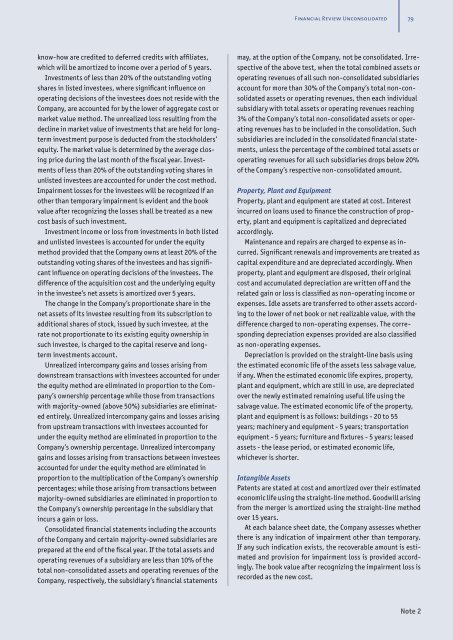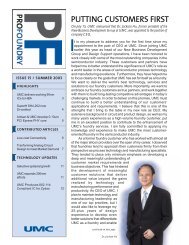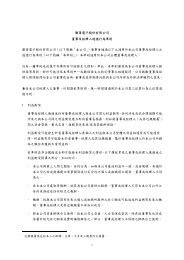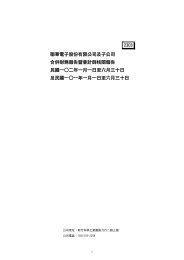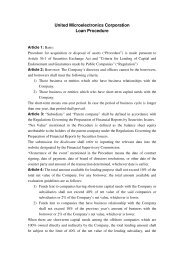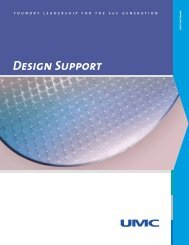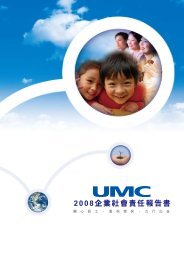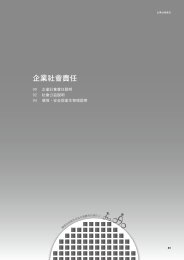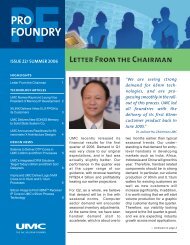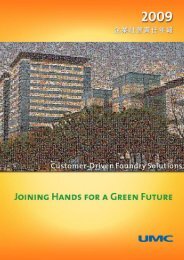Download Full Version - UMC
Download Full Version - UMC
Download Full Version - UMC
You also want an ePaper? Increase the reach of your titles
YUMPU automatically turns print PDFs into web optimized ePapers that Google loves.
Financial Review Unconsolidated<br />
79<br />
know-how are credited to deferred credits with affiliates,<br />
which will be amortized to income over a period of 5 years.<br />
Investments of less than 20% of the outstanding voting<br />
shares in listed investees, where significant influence on<br />
operating decisions of the investees does not reside with the<br />
Company, are accounted for by the lower of aggregate cost or<br />
market value method. The unrealized loss resulting from the<br />
decline in market value of investments that are held for longterm<br />
investment purpose is deducted from the stockholders’<br />
equity. The market value is determined by the average closing<br />
price during the last month of the fiscal year. Investments<br />
of less than 20% of the outstanding voting shares in<br />
unlisted investees are accounted for under the cost method.<br />
Impairment losses for the investees will be recognized if an<br />
other than temporary impairment is evident and the book<br />
value after recognizing the losses shall be treated as a new<br />
cost basis of such investment.<br />
Investment income or loss from investments in both listed<br />
and unlisted investees is accounted for under the equity<br />
method provided that the Company owns at least 20% of the<br />
outstanding voting shares of the investees and has significant<br />
influence on operating decisions of the investees. The<br />
difference of the acquisition cost and the underlying equity<br />
in the investee’s net assets is amortized over 5 years.<br />
The change in the Company’s proportionate share in the<br />
net assets of its investee resulting from its subscription to<br />
additional shares of stock, issued by such investee, at the<br />
rate not proportionate to its existing equity ownership in<br />
such investee, is charged to the capital reserve and longterm<br />
investments account.<br />
Unrealized intercompany gains and losses arising from<br />
downstream transactions with investees accounted for under<br />
the equity method are eliminated in proportion to the Company’s<br />
ownership percentage while those from transactions<br />
with majority-owned (above 50%) subsidiaries are eliminated<br />
entirely. Unrealized intercompany gains and losses arising<br />
from upstream transactions with investees accounted for<br />
under the equity method are eliminated in proportion to the<br />
Company’s ownership percentage. Unrealized intercompany<br />
gains and losses arising from transactions between investees<br />
accounted for under the equity method are eliminated in<br />
proportion to the multiplication of the Company’s ownership<br />
percentages; while those arising from transactions between<br />
majority-owned subsidiaries are eliminated in proportion to<br />
the Company’s ownership percentage in the subsidiary that<br />
incurs a gain or loss.<br />
Consolidated financial statements including the accounts<br />
of the Company and certain majority-owned subsidiaries are<br />
prepared at the end of the fiscal year. If the total assets and<br />
operating revenues of a subsidiary are less than 10% of the<br />
total non-consolidated assets and operating revenues of the<br />
Company, respectively, the subsidiary’s financial statements<br />
may, at the option of the Company, not be consolidated. Irrespective<br />
of the above test, when the total combined assets or<br />
operating revenues of all such non-consolidated subsidiaries<br />
account for more than 30% of the Company’s total non-consolidated<br />
assets or operating revenues, then each individual<br />
subsidiary with total assets or operating revenues reaching<br />
3% of the Company’s total non-consolidated assets or operating<br />
revenues has to be included in the consolidation. Such<br />
subsidiaries are included in the consolidated financial statements,<br />
unless the percentage of the combined total assets or<br />
operating revenues for all such subsidiaries drops below 20%<br />
of the Company’s respective non-consolidated amount.<br />
Property, Plant and Equipment<br />
Property, plant and equipment are stated at cost. Interest<br />
incurred on loans used to finance the construction of property,<br />
plant and equipment is capitalized and depreciated<br />
accordingly.<br />
Maintenance and repairs are charged to expense as incurred.<br />
Significant renewals and improvements are treated as<br />
capital expenditure and are depreciated accordingly. When<br />
property, plant and equipment are disposed, their original<br />
cost and accumulated depreciation are written off and the<br />
related gain or loss is classified as non-operating income or<br />
expenses. Idle assets are transferred to other assets according<br />
to the lower of net book or net realizable value, with the<br />
difference charged to non-operating expenses. The corresponding<br />
depreciation expenses provided are also classified<br />
as non-operating expenses.<br />
Depreciation is provided on the straight-line basis using<br />
the estimated economic life of the assets less salvage value,<br />
if any. When the estimated economic life expires, property,<br />
plant and equipment, which are still in use, are depreciated<br />
over the newly estimated remaining useful life using the<br />
salvage value. The estimated economic life of the property,<br />
plant and equipment is as follows: buildings - 20 to 55<br />
years; machinery and equipment - 5 years; transportation<br />
equipment - 5 years; furniture and fixtures - 5 years; leased<br />
assets - the lease period, or estimated economic life,<br />
whichever is shorter.<br />
Intangible Assets<br />
Patents are stated at cost and amortized over their estimated<br />
economic life using the straight-line method. Goodwill arising<br />
from the merger is amortized using the straight-line method<br />
over 15 years.<br />
At each balance sheet date, the Company assesses whether<br />
there is any indication of impairment other than temporary.<br />
If any such indication exists, the recoverable amount is estimated<br />
and provision for impairment loss is provided accordingly.<br />
The book value after recognizing the impairment loss is<br />
recorded as the new cost.<br />
Note 2


